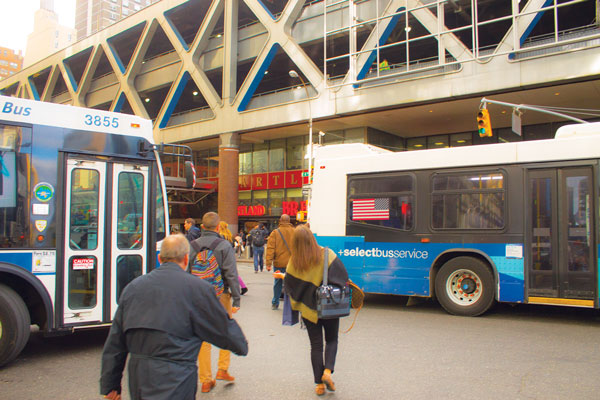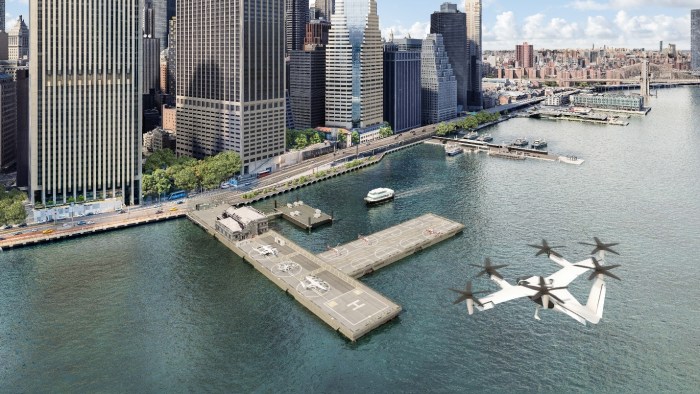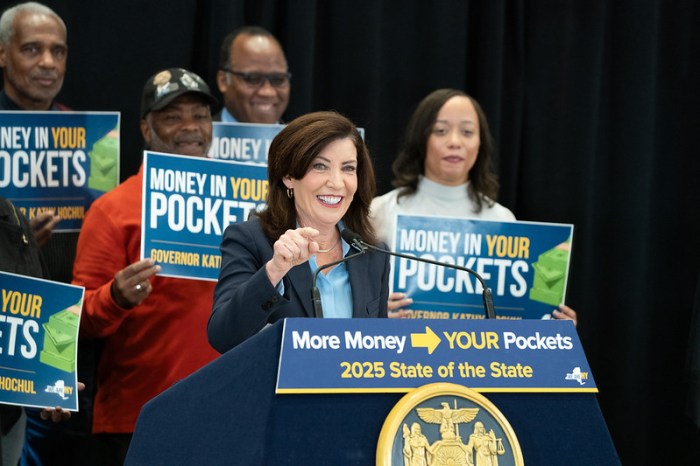
New traffic signals will divide the allotted times for pedestrian crossing and vehicle turning, at troublesome intersections in Hell’s Kitchen, such as this one at W. 45 St. and Ninth Ave.
BY ZACH WILLIAMS | With plans progressing for safety improvements to streets on the west side, the next few months will determine just how far transportation activists can succeed in pushing Vision Zero initiatives to the top of city and state legislative agendas.
This summer, the city’s Department of Transportation (DOT) will install six to ten split-phase traffic signals in Hell’s Kitchen as well as tweak traffic flow in the surrounding area in order to ease rush hour congestion. The signals are also known as Protected Only Phase Signal (PROPS), a term coined by Community Board 4 (CB4) Chair Christine Berthet.
Such devices separate the allotted times for pedestrian crossing and vehicle turning, the combination of which leads to a large share of traffic collisions. CB4 members will recommend potential intersections to the department from a list of about 15 located on Eighth and Ninth Aves., following a DOT presentation on the matter at the April 15 meeting of CB4’s Transportation Planning Committee.
The intersection of W. 45th St. and Ninth Ave. was on the list of candidates, and particularly illustrative of the push to make turning vehicles wait for pedestrians as through traffic resumes with a green light. It was at that very intersection that a woman entered the crosswalk amidst the rush hour traffic as a cab sped towards a southbound turn — and a collision course with her. She spoke on a cell phone as she walked across the Ninth Ave., before the taxi driver hit the brakes a split-second before he would have run her over.
Such close calls could soon be a thing of the past at the intersection, which is also a candidate for funding through District 3’s Participatory Budgeting process. Pedestrian safety activists placed a $250,000 initiative on the ballot to pilot a combination of a speed bump and pedestrian crossing there. The “speed table” would simultaneously boost visibility and slow down turning vehicles. Results of the April 11–19 election will be announced on May 9 at the West Side Forum, to be held at Civic Hall (156 Fifth Ave. btw W. 20th & W. 21st Sts.) from 12–3 p.m. The office of Councilmember Corey Johnson will allocate a total of $1 million in funding to the top vote-getters.
While the future improvements to the intersection at W. 45th St. and Ninth Ave. remain uncertain, an ongoing collaboration between Johnson’s staff and the city Department of Health and Mental Hygiene seeks to better distribute data to city agencies about how best to allocate resources in order to further the Vision Zero initiative.
“By linking crash and hospital records, we can better understand the linkages between particular crashes and injuries and help target traffic safety interventions,” he said in a statement.
Recognizing the spatial needs of all streets users is an important element of the Vision Zero initiative to eliminate traffic fatalities and serious injuries in New York City by 2024. One piece of legislation before the city council this year, however, reflects a desire for legal protections for a special group of motor vehicle operators in the wake of the nearly two dozen new laws passed last year in relation to the initiative.
One new city law made it a misdemeanor if a driver hurts or kills a pedestrian who has the right of way in a crosswalk. A new bill before the city council would exempt city bus drivers from the law, following uproar from organized labor that the nature of the job inherently puts drivers in tricky situations. The bill remains before the council’s Transportation Committee with no hearing yet scheduled, according to the council’s website.
Industry opposition has also stalled an effort in the state legislature to require large trucks to install metal guards, which would prevent pedestrians from falling under a striking vehicle, according to State Senator Brad Hoylman. In a telephone interview, he noted that another bill would require that taxi passengers wear a seat belt or else pay a fine.
About 60 percent of taxi riders currently do not use safety belts, resulting in about a dozen injuries each day throughout the state, according to data compiled by NYU Langone Medical Center, which helped inspire the bill. The idea reiterates a common theme to Vision Zero. Ordinary New Yorkers must step out of the “safety cocoon” and recognize the role of small actions in furthering higher goals, according to Hoylman.
“It always struck me that taxi customers have this false sense of security that we need to disabuse them of,” he said.
Both bills remain in committee for the time being. At the city level though, a pilot program will install side guards on city trucks. Several years will pass before the entire 4,700-vehicle fleet fully adopts them, according to Johnson. In the coming weeks however, the council will decide if private operators should adopt them as well, he added.
“The continued deaths of cyclists and pedestrians under the carriages of trucks speaks to the importance of a simple design change that can save lives,” he said in the statement.

MTA drivers want an exception to a law passed last year which makes it a misdemeanor to injure or kill a pedestrian who has the right of way in crosswalks, such as this one at W. 41st St. and Eighth Ave.
Meanwhile, a fight is also brewing between the city and Transportation Alternatives, a local street safety advocacy group, about whether enough municipal funding will go to Vision Zero initiatives through the city’s upcoming 2016 budget, preliminary 10-year capital plan and current DOT commitments. The group staged a lobby day at City Hall on April 13 to convince city councilmembers to back increased funding for street improvements.
Plans to complete 50 “safety-oriented operational street projects” in 2016 are less than the 60 projects completed by the DOT in 2014, Transportation Alternatives notes in policy recommendations available on their website (transalt.org). At the proposed rate of reconstructing 35 lane-miles per year of the city’s most dangerous arterial streets, Vision Zero would take a century to realize, according to the group’s analysis of the preliminary capital plan.
It’s not only a question of safety but also promoting a new identity for the city, which still features a streetscape from the previous era when automobiles dominated the approach of city planners, according to Transportation Alternatives.
“In New York, one of the most pedestrian-rich cities in the country, the arterial streets that crisscross a majority of neighborhoods look as automobile-centric as the highways of Houston, Phoenix or Atlanta, and the results are dangerous for everyone,” states the analysis.


































